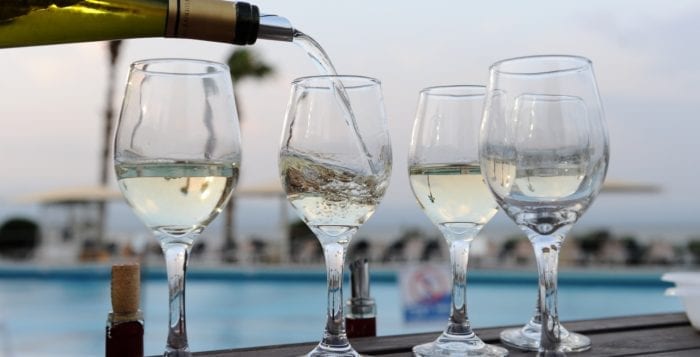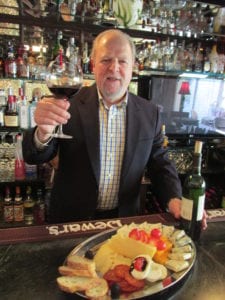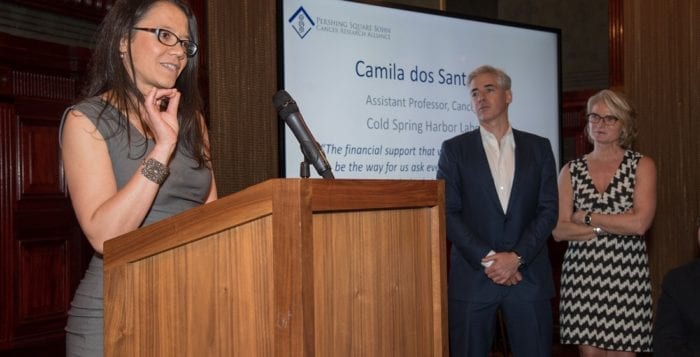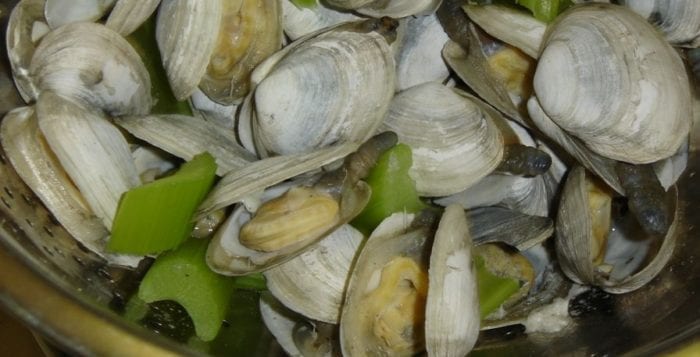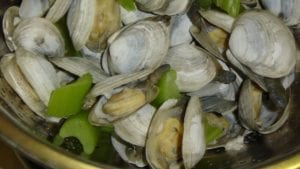By Daniel Dunaief
They aren’t quite wonder twins, but some day the dedicated work of husband and wife scientists Christopher Vakoc and Camila dos Santos may help people batting against a range of cancers, from leukemia to breast cancer.
An assistant professor at Cold Spring Harbor Laboratory, dos Santos recently won the prestigious and highly coveted Pershing Square Sohn prize. Dos Santos, who studies breast cancer, will receive $200,000 in funds per year for the next three years. She won the same prize her husband, an associate professor at Cold Spring Harbor Laboratory, collected two years earlier for his work using the gene-editing technique CRISPR to study the molecular pathways involved in leukemia.
Dos Santos and Vakoc are the first family of prize winners in the Pershing Square Foundation’s five years of supporting research in the New York area.“The board was very much taken by how original her approach is and how thoughtful she is about it,” said Olivia Tournay Flatto, president of the foundation. “There was a lot of early stage data that would say that the observations she’s making are interesting to pursue, but that the National Institutes of Health would not fund. We felt this was something we wanted to be a part of.”
Dos Santos is studying so-called epigenetic changes that protect women from breast cancer if they become pregnant before they are 25. Women who have pregnancies before that cut-off age have a 30 to 40 percent decrease in breast cancer, even decades after their pregnancy.
Dos Santos has been digging into this process, looking at why some women who are pregnant before this age still develop breast cancer later in life.
The Cold Spring Harbor scientist is exploring how infections block the protective effects of pregnancy. She hasn’t defined the panel of infections that could influence cancer risk before or after pregnancy. The hypothesis in her work is that “the whole process that is fighting inflammation could change the breast cells,” which could “take away the advantage that pregnancy brings.”
If she proves her theory — that changes to inflammation could take away benefits of an early pregnancy — she could define changes to proteins and genes as biomarkers to predict the risk of breast cancer, even in the event of an early pregnancy. One of the challenges in the three-step application process for this prize was to explain to a group of experts how what she’s doing was different from what others are pursuing. Her approach is to look at cells before and during the process of turning into cancer cells. That strategy led to the current hypothesis, which was the basis for her application for this prize.
To study breast cancer, dos Santos recently developed a mouse model in her lab, to see how pregnancy changes pre-malignant lesions. When the mice they are studying have a gene that would turn into cancer, some of them don’t develop cancer if they’ve already been pregnant. Those mice that haven’t been pregnant develop cancer. She uses this mouse model to ask questions about how pregnancy changes a cell such that oncogenes cannot operate to change a cell into a cancer.
“We are not only investigating how prevention works, but we are also learning what signals break that prevention,” dos Santos said.
Dos Santos has used the mouse model experiments to test an unusual element to human breast cancer resistance. Women who reach their second trimester before 25, but don’t give birth to a child, have the same resistance, decades later, to breast cancer. Mice whose pregnancies last through the equivalent of the second trimester also experience similar epigenetic benefits.
She has tested mice who have a pseudo-pregnancy —who have higher pregnancy hormone levels without being pregnant — to see if a similar pregnancy environment would convey the same resistance. “Even in those cases, with no fetus, no embryo, no birth and no nursing, we see that the epigenetics changes,” dos Santos said. The scientist plans to use the funds from this award to perform high-tech experiments, such as single-cell, multiple mouse models and human tissue analysis that she wouldn’t have been able to tackle without the funding.
Dos Santos is grateful for the funding, which she said she wouldn’t have been able to secure through other means based on “the stage we are right now,” she said. The work is “risky” and “provocative,” but it’s also “outside of the box ideas and experiments and approaches.”
When she puts all the variants together, the risky outcome could be beneficial, leading to a better understanding of how to copy or, perhaps, understand nature to try to cure or prevent cancer.
Dos Santos said she learned about the award when she was on a train on the way to Jamaica, where she was catching a flight to Washington, D.C. She said she turned into a “texting machine,” sharing the good news with everyone, including her husband Vakoc, who called her as soon as he saw the news. “He was super happy,” she recalled.
She said Vakoc was particularly helpful in discussing the work and in watching their sons Lucas and Marcus who are 8 and 5, respectively. She also received some unexpected help from him before an extensive seven- to eight-minute finalist screening process.
She asked him about the interview, and he remembered that there were five people in the audience and that he didn’t get that many questions. When she appeared for her interview, she saw about 25 people in the audience and received numerous questions. In a way, she said, his memory of his experience may have helped her, because she didn’t have time to worry about the size of the audience or the number of questions.
Dos Santos said their sons are proud of their parents for winning awards for their work on cancer.
When her sons are upset with dos Santos, they sometimes warn, reflecting their parents’ threat to take away TV, that they’re going to “take your epigenetics away.”
Dos Santos said the couple maintains a healthy work-life balance. She is grateful for her husband’s support, as well as for the environment and expertise at Cold Spring Harbor Laboratory.
“Here at the lab, we not only have the technology to move this forward, but we also have a pretty outstanding body of scientists that are very collaborative,” she said.
 Laura Sprowls of Setauket recently captured this image of Port Jefferson Harbor from the dock at Danfords Hotel. She writes, “The lighting was strong so I put the sun behind the mini lighthouse to soften the effect and captured a lovely reflection in the calm evening water at the end of a beautiful summer’s day.”
Laura Sprowls of Setauket recently captured this image of Port Jefferson Harbor from the dock at Danfords Hotel. She writes, “The lighting was strong so I put the sun behind the mini lighthouse to soften the effect and captured a lovely reflection in the calm evening water at the end of a beautiful summer’s day.”



 Fiber has very powerful effects on our overall health. A very large prospective cohort study showed that fiber may increase longevity by decreasing mortality from cardiovascular disease, respiratory diseases and other infectious diseases (1). Over a nine-year period, those who ate the most fiber, in the highest quintile group, were 22 percent less likely to die than those in lowest group. Patients who consumed the most fiber also saw a significant decrease in mortality from cardiovascular disease, respiratory diseases and infectious diseases. The authors of the study believe that it may be the anti-inflammatory and anti-oxidant effects of whole grains that are responsible for the positive results.
Fiber has very powerful effects on our overall health. A very large prospective cohort study showed that fiber may increase longevity by decreasing mortality from cardiovascular disease, respiratory diseases and other infectious diseases (1). Over a nine-year period, those who ate the most fiber, in the highest quintile group, were 22 percent less likely to die than those in lowest group. Patients who consumed the most fiber also saw a significant decrease in mortality from cardiovascular disease, respiratory diseases and infectious diseases. The authors of the study believe that it may be the anti-inflammatory and anti-oxidant effects of whole grains that are responsible for the positive results.

